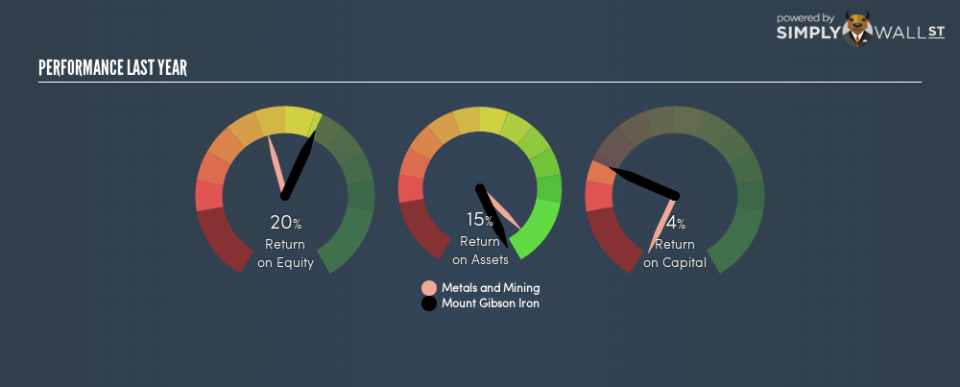Shareholders Should Look Hard At Mount Gibson Iron Limited’s (ASX:MGX) 4.0% Return On Capital

Want to participate in a short research study? Help shape the future of investing tools and you could win a $250 gift card!
Today we are going to look at Mount Gibson Iron Limited (ASX:MGX) to see whether it might be an attractive investment prospect. To be precise, we’ll consider its Return On Capital Employed (ROCE), as that will inform our view of the quality of the business.
First up, we’ll look at what ROCE is and how we calculate it. Then we’ll compare its ROCE to similar companies. And finally, we’ll look at how its current liabilities are impacting its ROCE.
What is Return On Capital Employed (ROCE)?
ROCE measures the amount of pre-tax profits a company can generate from the capital employed in its business. All else being equal, a better business will have a higher ROCE. In brief, it is a useful tool, but it is not without drawbacks. Author Edwin Whiting says to be careful when comparing the ROCE of different businesses, since ‘No two businesses are exactly alike.’
So, How Do We Calculate ROCE?
The formula for calculating the return on capital employed is:
Return on Capital Employed = Earnings Before Interest and Tax (EBIT) ÷ (Total Assets – Current Liabilities)
Or for Mount Gibson Iron:
0.04 = AU$22m ÷ (AU$590m – AU$52m) (Based on the trailing twelve months to June 2018.)
Therefore, Mount Gibson Iron has an ROCE of 4.0%.
See our latest analysis for Mount Gibson Iron
Does Mount Gibson Iron Have A Good ROCE?
ROCE can be useful when making comparisons, such as between similar companies. We can see Mount Gibson Iron’s ROCE is meaningfully below the Metals and Mining industry average of 12%. This could be seen as a negative, as it suggests some competitors may be employing their capital more efficiently. Independently of how Mount Gibson Iron compares to its industry, its ROCE in absolute terms is low; especially compared to the ~2.3% available in government bonds. There are potentially more appealing investments elsewhere.
Mount Gibson Iron has an ROCE of 4.0%, but it didn’t have an ROCE 3 years ago, since it was unprofitable. This makes us wonder if the company is improving.
Remember that this metric is backwards looking – it shows what has happened in the past, and does not accurately predict the future. Companies in cyclical industries can be difficult to understand using ROCE, as returns typically look high during boom times, and low during busts. This is because ROCE only looks at one year, instead of considering returns across a whole cycle. Given the industry it operates in, Mount Gibson Iron could be considered cyclical. What happens in the future is pretty important for investors, so we have prepared a free report on analyst forecasts for Mount Gibson Iron.
Mount Gibson Iron’s Current Liabilities And Their Impact On Its ROCE
Current liabilities include invoices, such as supplier payments, short-term debt, or a tax bill, that need to be paid within 12 months. The ROCE equation subtracts current liabilities from capital employed, so a company with a lot of current liabilities appears to have less capital employed, and a higher ROCE than otherwise. To counter this, investors can check if a company has high current liabilities relative to total assets.
Mount Gibson Iron has total assets of AU$590m and current liabilities of AU$52m. As a result, its current liabilities are equal to approximately 8.9% of its total assets. With barely any current liabilities, there is minimal impact on Mount Gibson Iron’s admittedly low ROCE.
The Bottom Line On Mount Gibson Iron’s ROCE
Still, investors could probably find more attractive prospects with better performance out there. Of course you might be able to find a better stock than Mount Gibson Iron. So you may wish to see this free collection of other companies that have grown earnings strongly.
I will like Mount Gibson Iron better if I see some big insider buys. While we wait, check out this free list of growing companies with considerable, recent, insider buying.
To help readers see past the short term volatility of the financial market, we aim to bring you a long-term focused research analysis purely driven by fundamental data. Note that our analysis does not factor in the latest price-sensitive company announcements.
The author is an independent contributor and at the time of publication had no position in the stocks mentioned. For errors that warrant correction please contact the editor at editorial-team@simplywallst.com.

 Yahoo Finance
Yahoo Finance 
